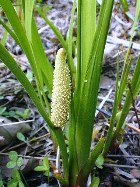
Plant Part: Root
Extraction: Steam Distilled
Growing Practice: Ethical
Country of Origin: Nepal
Odor Type: SPICY
Odor Characteristic: Odor is unusual warm, woody-spicy with increasing sweet afternotes and good tenacity.
Refractive Index: 1.53350 to 1.55890 @ 23°C
Specific Gravity: 1.0695 to 1.0795 at 23 @ 15°C
Appearance: yellow to yellowish brown slightly viscous liquid
BioChemical Class: Ketone
CAS No: 8015-79-0
INCI Name: ACORUS CALAMUS ROOT OIL
About the Plant
From the Acoraceae family, Acorus calamus is a tall perennial wetland monocot with scented leaves and more strongly scented rhizomes. Commonly known as sweet flag, sweet root, its Sanskrit name is vacha. While it is thought to have originated in Central Asia or India in the common areas that surround the Himalayas, this very decorative plant now grows wild in all temperate zones of Europe, Asia and America, along brooks, rivers, lakes, etc. It was introduced to N. America by early European settlers who grew it for medicinal purposes. The muskrat appears to be an animal responsible for its profliferation because they eat the rhizomes and collect them for future use, and under proper conditions, the pieces may produce new roots. Because the rhizomes can be dried without a substantial loss of essential oil provided they are kept unpeeled, distillation can take place in many countries far from the country of plant origin. The plant has branched, aromatic rhizomes with sword-like leaves that are sharp pointed with a ridged midrib running the entire length.. In late spring, green flowers appear in 2 to 4 long spadices below the leaf tips. Flowers eventually give way to small berries. Calamus grows in both temperate and sub-temperate areas of the globe.The blue flag, also called poison flag, has similar leaves to those of calamus. Blue flag rhizomes can be dangerously toxic, so if you are wildcrafting this plant, make sure you can tell the difference.
History
Acorus calamus root has a long history of medical usage. It is known as an old folk remedy for the treatment of arthritis, neuralgia, diarrhea, dyspepsia, hair loss and other disorders.The plant is mentioned by many of the great classical writers on medicine, from Hippocrates (460-377 BC) and Theophrastus (371-287 BC) onwards. According to Dioscorides, the smoke of Acorus calamus (if taken orally through a funnel) relieves a cough.
For centuries, many Native American tribes were familiar with calamus. It was used as an anesthetic for toothache and headaches. So mainly it was used as folk medicine. The Cree say that they can take Acorus calamus root and travel great distances without touching the ground.
Calamus or sweet flag is or was known by the American Indian tribes and early settlers, was well known for its medicinal value. Although the preparation of this species and the ailments it treats vary somewhat among the tribes, rhizomes are the most commonly used part.
The unpeeled, dried rhizome was listed in the U.S. Pharmacopoeia until 1916 and in the National Formulary until 1950, for medicinal use on humans. In Europe, it is used for the stomach and bowel because it stimulates the salivary glands and production of stomach juices, helping to counter acidity and ease heartburn and dyspepsia.
Perfumery The essential oil has odor qualities similar to dried milk or sweet leather, slightly creamy-nutty.![]()
The information provided on these pages is not a substitute for necessary medical care, nor intended as medical advice. Always keep aromatic extracts tightly closed and in a cool, dark place, out of reach of children. Never ingest aromatic extracts. Always dilute aromatic extracts when applying topically and avoid areas around eyes or mucous membranes. If redness or irritation occurs, stop using immediately and contact your health provider if necessary.![]()
all images and content copyright ©2000—2020 by suzumebachi design and samara botane





